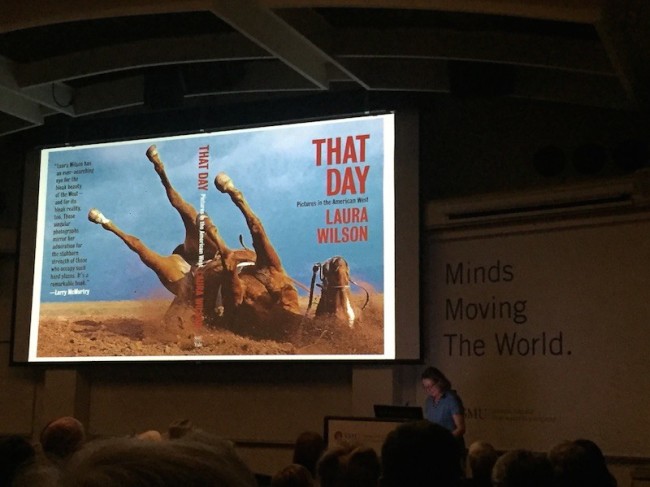Laura Wilson is a photographer who came to SMU to discuss her most recent publication, “That Day: Pictures in the American West,” a 231 page photographic journey into the modern West. She gave a lecture and signed books on Wednesday, Dec. 2 in a fully packed McCord Auditorium in Dallas Hall.

Wilson’s work has appeared in The New York Times Magazine, The New Yorker, Vanity Fair, GQ and many others. She is also to author of The Hutterites of Montana, Grit and Glory: Six-Man Football as well as Avedon at Work in the American West.
Wilson’s recent work, “That Day: Pictures in the American West” is published in conjunction with her second major exhibition at the Amon Carter Museum of American Art in Fort Worth, a showcase of 74 photographs. It is co-published by Yale University Press and the Clements Center for Southwest Studies at Southern Methodist University.
Andy Graybill is the co-director of Southwest Studies at SMU and an admirer of Wilson’s work. He began chatting with her about her own vision of the West in 2011 and what she may want to feature, which eventually resulted in “That Day: Pictures in the American West.”
“Her title is meant to evoke the immediacy of the moment in which she took each photograph,” said Graybill.
The book contains Wilson’s photographs along with writing from her journals.
“I think she writes as well as she photographs,” said Graybill.
Her presentation was an explanation of each individual photograph.
Sarah Reyes, a photographer and designer, came to the speech with her partner after seeing the exhibit in Amon Carter. She heard of it when she was searching Wilson’s name on Google. Reyes said that she found the speech was a lot like the descriptions from the Amon Carter exhibit. One aspect that Wilson touched upon during her lecture was her ability to get people to allow her to shoot; she never took no for an answer.
“As someone who photographs other people, I think there is a lot more to it. I’m impressed in the way she is able to get people to surrender hostilities and get the shot,” Reyes said.
“I am drawn to people who live in an enclosed world,” Wilson stated.
She captures some of these people through her photographs of the modern West.
She covers a wide range of subject from ranches, to nature, border towns, cockfighting, dogfights and more. Through her eyes, the history of the West is preserved in black and white.
She shows off the strong yet fragile nature of one of the West’s great predators, the coyote. She states that the “coyote has only one predator, that is man.” Her photograph of about six coyotes hung from a tree being prepared for skinning is striking in black and white.
Wilson contrasts some of her graphic imagery, like that of Border Patrol and border area inhabitants with the pageantry and celebration of George Washington’s birthday in Laredo, Texas. This celebration culminates in a lavish ball, where seventeen debutantes are presented in extravagant dresses that could take up to a year to make. These gowns are so large that the girls are transported in large moving trucks, strapped in like race horses five girls line the back of a van, which amused the audience to no end.
Most strikingly, Wilson got shots of the girls backstage before the show, unable to stand under the weight of enormous and heavy gowns in which they sit.
“I thought they looked like little birds,” Wilson said.
She touched upon her work with the Hutterites of Montana. These photographs are just another example of Wilson’s tenacity, as it is against Hutterite policy to be photographed, thus it took many visits before she was allowed to take pictures- and then only in black and white.
The colony life intrigued her; they kept the groups small between 35 and 125 so as to keep the young involved in all aspects. She also admired their ability to deal with the same societal issues.
Wilson worked with one of the greatest photographers, Richard Avedon, and even has photos of him in this particular series. She was happy that the photograph used was taken as a snapshot, which she suggests anyone could take. The power of this sort of snapshot is that it still captures the intelligence and charm of the subject without being a posed photograph, which goes to show the power of such snapshots.
“There is no substitute for working under a great person,” she said of Avedon.











